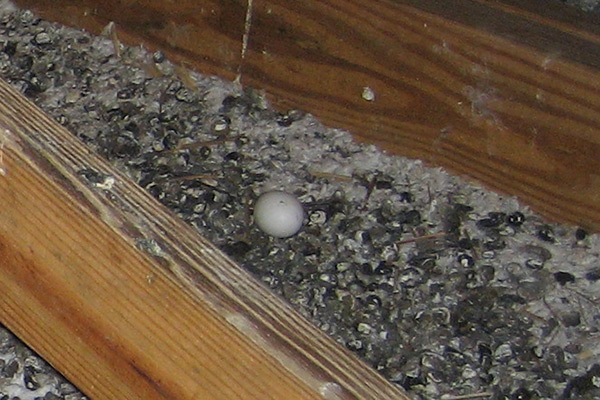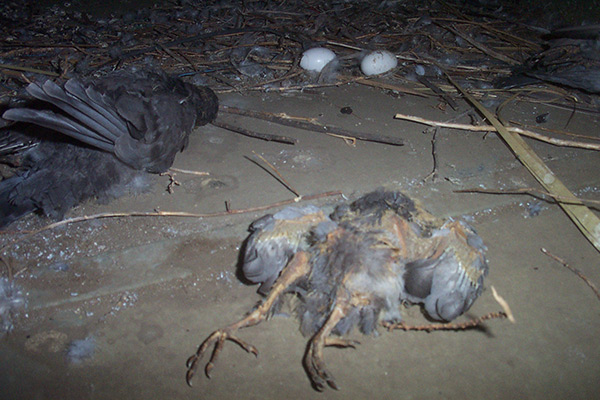- info@animalatticpest.com
- Call - we service 300 locations

Eggs in my Attic
Finding wildlife in your attic is one thing but finding eggs leads to a whole other set of problems. In most cases, the eggs will be accompanied by the mother animal, even if she is simply out hunting or gathering nesting material. At the very least, the presence of eggs in your attic indicates that a wild animal was there at some point and lived in your attic long enough to lay their eggs.
Photos of Eggs in the Attic

Egg and Pigeon Feces
Sometimes birds in an attic have a defined nest, but often they just lay eggs right in the unsulation amongst the droppings.

Eggs and Dead Birds
Here you can see some dead birds near the eggs in the attic. They won't hatch unless they are sat on. Unless the attic is hot enough, like an incubator.
Eggs In My Attic
Checking If The Mother Is Present
The first thing to do if you find eggs in your attic is to figure out whether or not the mother is still there. In some cases, this will require a little bit of patience since they may be out for a few hours gathering food. If you see a bird or snake in the attic, then you know that yes, the mother is there. If you don’t, look for signs of recent activity like fresh waste products or recent food-related debris.
Identifying The Eggs
In cases where the mother of the eggs isn’t in your attic and hasn’t come back, you will need to figure out what type of animal the egg belongs to. The easiest way to do this is to just a consult an expert and have them take a look for you. You may also be able to give a professional a description of the egg over the phone. When identifying the egg, you will want to pay attention to shape, color, size, location, and quantity.
Pigeon eggs, for example, may be placed within an obvious nest that people tend to associate with birds. They may also just be loose in your insulation surrounded by bird droppings. Their eggs are small and white in color and typically incubated by both parents. Because of this, it is rare to find an unattended pigeon egg in your attic. These birds typically lay about two eggs, although it can be more or less than this.
What about snake eggs in the attic? Snake eggs, on the other hand, are typically buried underneath soil and found in dark, isolated areas. Bird and snake eggs can be easily mistaken for each other, but snake eggs tend to be leathery and soft from the outside while bird eggs are hard. If you hold a snake egg up to the light, it will be translucent, letting you see inside and view the embryo’s silhouette.
What To Do With An Egg
Finding an egg of some sort in your attic is not necessarily as straightforward as finding a live animal, whether it is an adult or a newborn. If there are no signs of recent activity in the attic, then it is possible that this egg failed to hatch and was left behind when the mother animal and other babies left. In this case, however, a large amount of time would have needed to pass since the egg was laid as the baby animals in the other eggs would have already grown enough to leave. Ideally, whether or not the parents of the egg are present, you should contact a wildlife expert. They will be able to guide you to the correct course of action. In some cases, this may be putting off removing the animal and the egg until the bird or snake has hatched and grown a little. At other times, it may involve giving the egg to a wildlife rehabilitator. Professionals will also have a better idea of whether the egg is viable and be able to tell whether the parents are returning. In the case of birds, if parents aren’t present to incubate it, the egg is unlikely to hatch unless your attic is very warm. In the case of non-viable eggs, you will need to dispose of them.
Getting Rid Of The Animals
Assuming that in addition to the eggs, you have a bird, snake, or other animal in your attic, you will want to get rid of all of them. The best method is to wait until the animal inside the egg is grown so you can use methods such as exclusion or trapping and relocation to get them out of the space. In some cases, it may be possible to remove the adult animal and the egg, but this puts the embryo inside the egg at risk.
Always Clean Up
After you have dealt with the egg in your attic, whether it is a snake egg in the attic or bird egg in the attic, you need to clean up the space just like you would if you removed a full-grown animal. Take the time to remove waste products, nesting materials, and any other eggshells that are round. You should also use an enzyme cleaner on the entire area as this is the only way to be sure that every single nook and cranny in the attic is cleaned. Don’t forget to seal up any holes leading to your attic as this is how the egg’s mother got inside and could allow more wildlife to get in.
